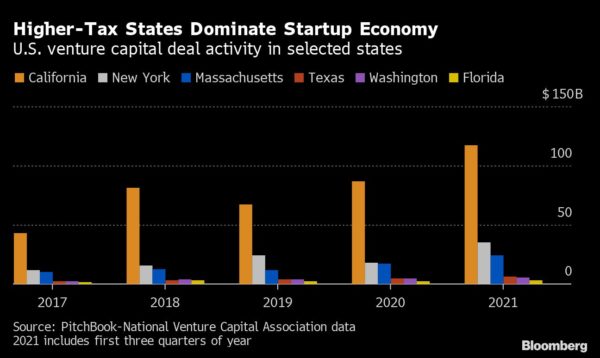By Ben Steverman
For America’s wealthy, the tax gap between states is getting more difficult to ignore.
More than a dozen states, most run by Republicans, have cut income taxes on the wealthy since the start of the pandemic. By contrast, Democrat-controlled New York, New Jersey, Washington State and the District of Columbia hiked rates on their highest-earners.

The stakes have never been higher, especially after former President Donald Trump signed into law a cap on the federal state and local tax, or SALT, deduction at $10,000 per year. Congressional Democrats are currently debating changes to the limit.
Academic research has found taxes have historically had little impact on where people live — particularly on the wealthy who can afford to reside wherever they want. States like California, which levies the U.S.’s highest rate of 13.3% on income over $1 million, remain economic dynamos, places where huge fortunes continue to be minted.
But there’s no doubt at least some very wealthy people are re-locating to lower-tax locales, bringing billions of dollars of tax revenue with them. Elon Musk, the world’s richest person, moved from California to Texas. Super-rich New Yorkers — including billionaire investor Carl Icahn and Trump — fled to Florida, and the biggest financial firms, including Goldman Sachs Group Inc., Apollo Global Management Inc. and Point72 Asset Management, followed suit, taking steps to expand in the Sunshine State and other locations far from Wall Street.
As Red and Blue states diverge so sharply on taxes and spending, they’re making competing bets with potentially massive economic consequences.
“Eventually, [lawmakers in high-tax states will] have to deal with the consequences of seeing wealthier people leave,” said Katherine Loughead, senior policy analyst at the conservative Tax Foundation. “Some people are willing to accept higher tax rates, but you get to a point where it gets too high and people look to do business elsewhere.”
Republican lawmakers around the country are also looking enviously at states with no state income taxes at all, including Florida, Texas and Nevada, that have seen their populations and economies grow quickly over the last decade, Loughead said. Unexpectedly strong tax revenue is allowing states to cut taxes now. Fears at the beginning of the pandemic of large budget shortfalls haven’t materialized.

“The competition is definitely heating up,” she said.
This year Tennessee joined the club of states with no income tax. The Volunteer State, which already had no levy on salaries or wages, phased out its tax on interest and dividend income in 2021. New Hampshire is following a similar path: The state’s income tax, limited to investment income, is being eliminated by lowering the rate to zero over several years.
Lawmakers in Arizona, Arkansas, Idaho, Iowa, Louisiana, Missouri, Montana, North Carolina, Ohio and Oklahoma have also approved cuts to their top personal income tax going into effect either this year or in future years.
“There are states moving in different directions,” said Carl Davis, research director at the left-leaning Institute on Taxation and Economic Policy. In Blue states, tax hikes are being floated by Democratic lawmakers as a partial solution to “a period of drastically widening inequality,” he said, while in Red states, “a lot of times these are sold as being part of an economic development strategy.”
The Tax Foundation estimates that states without an income tax grew their economies 56% faster than states that have an income tax over the last decade, while growing their populations at twice the national rate.
Low taxes aren’t necessarily the reason for that growth, however. “For every state that’s performed well economically with low taxes, there’s a state that’s performed well economically with high taxes,” ITEP’s Davis said.
In fact, when it comes to the innovation and technology creating vast new fortunes, states with high taxes and more generous public services have a clear edge over states with leaner governments that put less burden on the wealthy.
California receives about half of U.S. venture capital funding, a flow of money to startups that has surged in the past few years. U.S. venture investments totaled nearly $239 billion in the first three quarters of 2021, according to PitchBook-National Venture Capital Association data, up from $166 billion in all of 2020 and just $88 billion in 2017.
The Golden State’s only significant rivals for those investing dollars are New York, with almost 15% of the total and Massachusetts with 10%. Texas, the second-largest state by population after California, got just 2.7% of venture dollars, while Florida, the third largest, netted a paltry 1.3%.
“People are not very sensitive to their tax rates,” said Cristobal Young, a Cornell University sociology professor, who has studied the issue. Wealthy people often have close ties in the places where they got rich, making them “much less likely to migrate than other folks,” he said. “You can save a lot of money on your taxes, if you’re willing to give up your lifestyle and move to a place where people don’t know who you are.”
Though a few millionaires and billionaires are “very mobile,” — think of 20-something crypto investors — “there just aren’t that many of them,” Young said.
Still, there’s no denying that places like New York are getting more expensive for millionaires and billionaires who live there.
New York’s latest tax hike, retroactive to the beginning of 2021, boosted the state’s top rate, on income of more than $25 million, to 10.9%, from 8.82%. Add on New York City’s income tax of 3.876%, and super-wealthy residents of the city are paying a top rate of 14.8% — higher than California’s 13.3%.
Even as Tennessee and New Hampshire made moves to eliminate their income tax, Washington is adding one. A 7% capital gains tax will apply to profits of more than $250,000 per year. The law, signed by Governor Jay Inslee in May, goes into effect in January.
The financial impact of these tax hikes are magnified by the $10,000 SALT cap, which is slated to expire in 2026. “You’re essentially getting taxed twice on these dollars because you’re not able to deduct them from your return,” said Matt Masterson, a partner at New Jersey-based advisory firm RegentAtlantic.
Young, of Cornell, estimates the SALT cap effectively widened the average tax gap between states by 36%, the largest difference since at least the early 1980s.
Last month the U.S. House of Representatives approved a bill that would raise the SALT cap to $80,000, allowing the wealthy to deduct at least some of their state tax bills. Senate Democrats have proposed tweaking the bill so that that the richest taxpayers can’t benefit from the higher cap, by permitting an unlimited deduction that phases out above a certain income threshold. Senators disagree on what that threshold should be, with Vermont independent Bernie Sanders favoring $400,000 and New Jersey Democrat Bob Menendez pushing for an income limit just under $1 million.
Even if Congress doesn’t change the rules, some wealthy taxpayers are getting relief from high SALT bills anyway. About 20 states have passed laws that permit a SALT workaround for business owners. With a so-called pass-through entity tax, individual owners can effectively get an unlimited SALT deduction, by getting credit for taxes paid by the businesses they own.
“The more they’re used, the less of a factor that the SALT cap becomes for business owners,” Davis said.
More stories like this are available on bloomberg.com.




